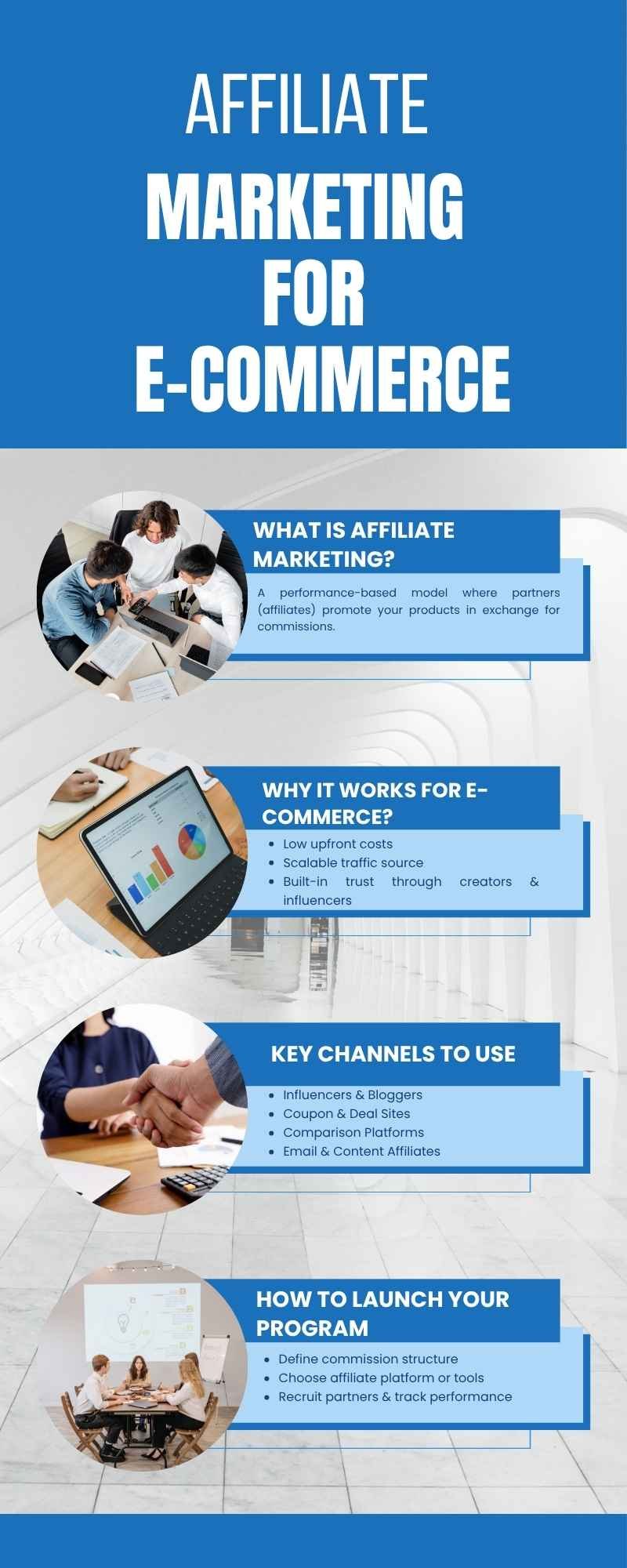Affiliate Marketing for E-commerce isn’t just another promotional tactic; it’s a growth engine powered by partnerships. Instead of spending upfront on ads, brands collaborate with content creators, influencers, or comparison websites who promote products in exchange for commission only when a sale happens. That makes Affiliate Marketing for E-commerce one of the most cost-efficient channels for scaling online stores. Unlike paid ads or email marketing, affiliates bring audiences you may never reach otherwise, acting as micro-distributors across blogs, YouTube, social media, and niche forums. When structured with clear incentives and high-converting landing pages, ecommerce affiliate marketing turns word-of-mouth into trackable revenue.
How E-commerce Affiliate Marketing Works?
Affiliate Marketing for E-commerce is a simple partnership model where sellers reward promoters for driving measurable results, usually sales, leads, or clicks. Three key players run this system: the merchant (brand or online store), the affiliate (creator, blogger, or ad publisher), and the consumer who makes the final purchase.
When an affiliate promotes a product using a unique link, tracking cookies record the user’s journey. If the consumer buys within a specified window, the affiliate earns a commission. Depending on the brand’s ecommerce commission models, payments may be structured as CPS (Cost Per Sale), CPL (Cost Per Lead), or CPA (Cost Per Action).
This performance-based model ensures brands pay only for results, while affiliates enjoy passive income, making Affiliate Marketing for E-commerce one of the most scalable digital revenue systems today.
Affiliate Models Commonly Used in E-commerce
Affiliate Marketing for E-commerce has grown into a diverse ecosystem where brands collaborate with different partners to drive traffic, conversions, and brand awareness. Each model has its own audience focus, commission structure, and strengths. Below is a breakdown of the most common affiliate models, showing how they operate and what makes them effective.
| Model | Primary Audience | Common Commission Type | Pros | Cons |
| Coupon / Deal Sites & Cashback Platforms | Price-sensitive shoppers hunting for discounts and cashback deals | CPA (Cost per Action), Revenue Share | Attracts large volumes quickly, strong appeal during sales seasons | May attract one-time buyers rather than loyal customers |
| Blog Reviews, Comparison Sites, & Content Publishers | Researchers, buyers comparing products, and information-seeking audiences | CPC (Cost per Click), CPA, Hybrid | Builds trust through long-form content and reviews, improves SEO rankings | Slower to scale, requires strong content credibility |
| Influencers, Social Media & Niche Creators | Engaged followers within specific niches on Instagram, YouTube, TikTok, etc. | CPA, Flat Fee + Performance Bonus | High engagement, strong brand storytelling, expands reach to new markets | ROI depends on influencer credibility and audience alignment |
| Loyalty & Reward Programs | Existing customers motivated by points, rewards, or referral bonuses | Revenue Share, Points-to-Cash | Encourages repeat purchases, builds brand loyalty, higher LTV | Limited new customer acquisition, may reduce margin if overused |
Why These Models Matter
For any brand exploring Affiliate Marketing for E-commerce, understanding which model aligns with its goals is crucial. Coupon affiliate marketing may work well for rapid conversions, while influencers and content publishers build long-term trust and organic reach. Loyalty programs, on the other hand, ensure customers keep coming back, adding sustainability to growth strategies.
Setting Up Your E-commerce Affiliate Program
Launching an affiliate program can be one of the smartest moves in Affiliate Marketing for E-commerce. It not only helps you scale visibility but also creates a consistent revenue channel. Below is a checklist-style guide to make the setup smooth and impactful.
Choosing the Right Affiliate Tools & Platforms
- Research and select affiliate software for e-commerce that integrates seamlessly with your online store (e.g., Shopify, WooCommerce).
- Prioritize platforms with real-time tracking, fraud protection, and easy pay-out systems.
- Ensure compatibility with multi-device traffic and international affiliates.
Defining Incentives, Commission Tiers & Cookie Windows
- Decide on a base commission that is competitive within your niche.
- Introduce tiered rewards for top-performing affiliates to boost motivation.
- Set cookie durations (30–90 days) to give affiliates a fair chance to earn credit for delayed purchases.
- Keep transparency around payment cycles and bonus structures.
Creating Marketing Assets & Onboarding Process
- Prepare branded creatives: banners, email templates, product visuals, and ready-to-use ad copy.
- Build an onboarding kit with clear program guidelines, policies, and FAQs.
- Offer affiliates tracking links and performance dashboards from day one.
- Set up communication channels (email, Slack, or community groups) for support and updates.
Quick Checklist:
- Select affiliate software.
- Finalize commission rules.
- Define cookie windows.
- Create marketing assets.
- Build onboarding flow.
Recruiting & Motivating High-Quality Affiliates
Recruiting top-performing partners is the backbone of Affiliate Marketing for E-commerce. Instead of chasing random influencers, focus on niche creators who already speak to your ideal buyers, beauty YouTubers for skincare brands, tech reviewers for gadgets, or fitness coaches for wellness stores. Approach them with value, not vague collaboration pitches. Offer tiered commissions, early product access, or exclusive discount codes that make promoting your brand genuinely rewarding. High-quality affiliates don’t join programs; they join opportunities where they feel recognized and fairly compensated.
But recruitment is only half the job; motivation is what keeps affiliates active long-term. Share performance insights, shout them out on brand channels, and send bonuses when they hit milestones. Treat your partners like an extended sales team, not a transaction. When Affiliate Marketing for E-commerce is built on a relationship rather than pay-out alone, affiliates naturally evolve from occasional promoters into consistent brand advocates.
Tracking, Analytics & Managing Commissions
Most affiliate programs fail not because of low traffic but because nobody’s actually tracking what’s working. If you’re serious about Affiliate Marketing for E-commerce, your dashboard is your command centre.
You can’t optimize what you don’t measure, so build your tracking stack early and watch it like a hawk.
KPIs You Must Monitor (Clicks, EPC, Conversion Rate, AOV)
Every affiliate sale goes through a journey — impression → click → purchase. Your job is to spot the leak.
| KPI | What It Tells You | Benchmark to Aim For |
| Clicks | Traffic quality & partner reach | Steady weekly growth |
| EPC (Earnings Per Click) | Revenue per click generated | ₹2–₹10 depending on niche |
| Conversion Rate | How well the landing page converts | 2–5% minimum |
| AOV (Average Order Value) | Revenue potential per sale | Constantly push higher |
Tools & Plugins for Attribution & Fraud Control
Relying on spreadsheets? That’s rookie territory. Use automation to protect profits.
- Post Affiliate Pro / Tapfiliate → complete affiliate dashboards
- FraudBlocker / TrafficGuard → detect bot clicks & fake leads
- WooCommerce / Shopify Commission Plugins → auto-pay-outs & tracking tags
Set first-click vs last-click attribution rules clearly; otherwise, disputes will eat into your time and your sanity.
Optimizing Based on Performance Data
Once your data starts speaking, act on it. Don’t pay high commissions to partners who send low AOV traffic. Instead:
- Reward top performers with exclusive coupon codes
- Test landing page variations for better EPC
- Move the budget towards affiliates with higher conversion consistency
That’s how Affiliate Marketing for E-commerce scales from chaos to a revenue machine, not by guessing, but by managing commissions with data-backed decisions.
Common Pitfalls & How to Avoid Them
When brands dive into Affiliate Marketing for E-commerce, they often get carried away with expansion and ignore the fine print, which is where cracks begin to show.
Setting Too Low Commissions
If your commission rates don’t excite affiliates, your program will never take off. Offering bare-minimum pay-outs might save budget today, but costs you high-performing partners tomorrow. Instead of squeezing margins, calculate commissions based on realistic customer lifetime value. Affiliate Marketing for E-commerce works best when both sides feel rewarded, not when one side is settling.
Affiliate Misrepresentation of Your Brand
Not every affiliate understands your positioning; some may overpromise discounts, use misleading copy, or showcase your product next to low-quality competitors. The fix? Provide strict brand guidelines, ready-to-use creatives, and monitor promotional channels regularly. Reputation takes years to build, but one careless affiliate post can damage it.
Ignoring Fraud, Overlaps & Attribution Issues
Duplicate referrals, cookie stuffing, fake leads, and affiliate fraud are more common than most brands think. Overlapping channels can also trigger unnecessary payouts. Use advanced tracking tools, cap rewards on suspicious activity, and define clear attribution rules between paid ads, influencers, and referral links to protect your ROI.
Avoid these affiliate marketing mistakes early, and your program will scale faster with far less clean-up later.
E-commerce Affiliate Program Examples That Work
When it comes to Affiliate Marketing for E-commerce, real success stories speak louder than theories. Let’s break down a few proven models from leading platforms to see what actually drives conversions.
Shopify Store Affiliate Programs: Shopify merchants often win by keeping things simple: high commissions and strong creative support. For example, Gymshark offers fitness influencers 10–15% per sale along with early access to product drops, making affiliates feel like insiders, not just promoters. The result? A loyal army of creators driving consistent traffic without paid ads.
BigCommerce Brands & Their Affiliate Strategy: BigCommerce brands tend to go niche and data-driven. Beardbrand, a men’s grooming store, tracks affiliate performance by content type, such as YouTube tutorials, beard care blogs, or TikTok skits, and doubles down on the highest-performing channels. Instead of bombarding affiliates with generic links, they provide tailored landing pages for each creator.
Niche E-commerce Success Stories: The pet niche is full of underrated wins. BarkBox partnered with dog meme pages on Instagram, not professional influencers. Just funny pages with high engagement. Each post featured a relatable “dog parent problem” with a swipe-up offer. Low cost, massive ROI proof that Affiliate Marketing for E-commerce doesn’t always need celebrity endorsements.
Future Trends in E-commerce Affiliate Marketing
The future of affiliate marketing for e-commerce is being shaped by smarter tech and more authentic connections. AI-driven affiliate matching is already transforming how brands choose partners, no more random collaborations. Instead, machine learning tools will pair e-commerce stores with affiliates based on audience behaviour, past conversion data, and purchase intent. That means higher ROI and less guesswork.
Another major shift is the rise of micro-influencers and user-generated content. Big celebrities are losing ground to everyday shoppers who create honest recommendations. Affiliate Marketing for E-commerce will rely more on relatable reviews, community-driven challenges, and social proof over flashy endorsements.
Finally, cross-channel attribution will become non-negotiable. Brands can no longer track performance on just one platform. In 2025, successful affiliate marketing trends will depend on seamless tracking across Instagram, YouTube, email, blogs, and even WhatsApp. Those who master omnichannel data will dominate the results.
Conclusion – Turning Affiliates into Predictable Growth Engines
When done right, Affiliate Marketing for E-commerce isn’t just a side channel; it becomes a scalable machine that delivers revenue on autopilot. The formula is simple: recruit partners who genuinely align with your brand, equip them with high-performing creatives, and continuously track what drives the highest ROI. Treat affiliates like long-term partners, not temporary promoters, and they’ll turn into repeat revenue generators. If you double down on solid tracking, transparent pay-outs, and performance-based incentives, Affiliate Marketing for E-commerce evolves from experimentation into a predictable, compounding growth engine.




